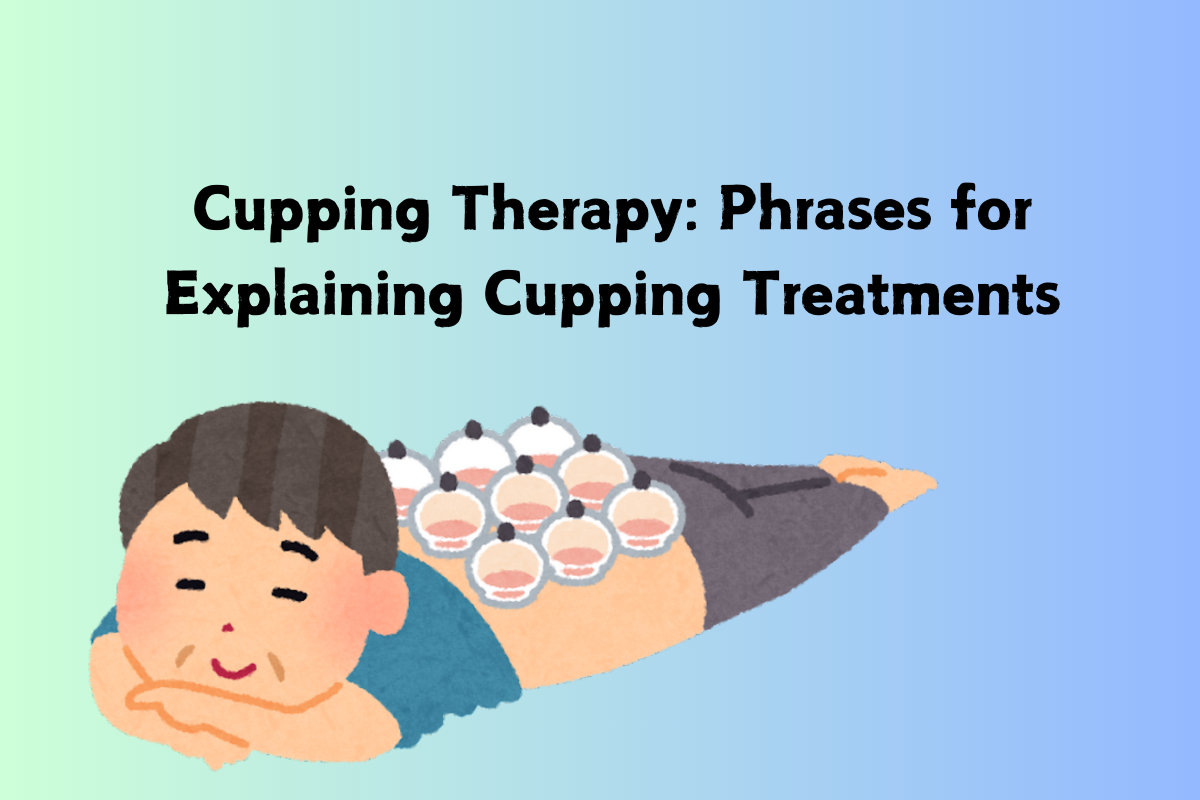Cupping Therapy: Phrases for Explaining Cupping Treatments
Cupping therapy is a popular Traditional Chinese Medicine (TCM) practice used to improve blood flow, relieve pain, and promote healing. The therapy involves placing cups on the skin to create suction, which may leave temporary marks. When visiting a clinic for cupping therapy in China, it's helpful to know key phrases to discuss the procedure, understand the treatment, and communicate any concerns. Below is a conversation format between a patient and a practitioner, with essential phrases for different scenarios during a cupping therapy session.

Scene 1: Discussing the Reason for Treatment
Patient:
I have been feeling very tense lately.
最近我感觉很紧张。
Zuìjìn wǒ gǎnjué hěn jǐnzhāng.
Practitioner:
Cupping can help relieve tension. Where do you feel it the most?
拔罐可以帮助缓解紧张。你主要感觉哪里不舒服?
Báguàn kěyǐ bāngzhù huǎnjiě jǐnzhāng. Nǐ zhǔyào gǎnjué nǎlǐ bù shūfú?
Patient:
Mostly in my shoulders and neck.
主要在我的肩膀和脖子。
Zhǔyào zài wǒ de jiānbǎng hé bózi.
Scene 2: Understanding the Procedure
Patient:
How does cupping work?
拔罐是怎么起作用的?
Báguàn shì zěnme qǐ zuòyòng de?
Practitioner:
The cups create suction on the skin, which improves blood circulation and reduces muscle tension.
拔罐在皮肤上产生吸力,这可以改善血液循环,减轻肌肉紧张。
Báguàn zài pífū shàng chǎnshēng xīlì, zhè kěyǐ gǎishàn xuèyè xúnhuán, jiǎnqīng jīròu jǐnzhāng.
Patient:
Will it hurt during the treatment?
治疗过程中会疼吗?
Zhìliáo guòchéng zhōng huì téng ma?
Practitioner:
It might feel tight or warm, but it shouldn't be painful.
你可能会感到紧绷或温热,但不应该疼痛。
Nǐ kěnéng huì gǎndào jǐnbēng huò wēnrè, dàn bù yīnggāi téngtòng.
Scene 3: During the Treatment
Patient:
The suction feels strong. Is this normal?
吸力感觉很强,这正常吗?
Xīlì gǎnjué hěn qiáng, zhè zhèngcháng ma?
Practitioner:
Yes, the suction should feel firm but not uncomfortable. Let me know if it’s too strong.
是的,吸力应该是有力但不过度不适。如果太强,请告诉我。
Shì de, xīlì yīnggāi shì yǒulì dàn bù guòdù bù shì. Rúguǒ tài qiáng, qǐng gàosù wǒ.
Patient:
How long will the cups stay on?
这些罐子会留多长时间?
Zhèxiē guànzi huì liú duō cháng shíjiān?
Practitioner:
They usually stay on for about 10 to 15 minutes.
通常会留10到15分钟。
Tōngcháng huì liú 10 dào 15 fēnzhōng.
Scene 4: After the Treatment
Patient:
Why are there marks on my skin?
为什么我的皮肤上有印子?
Wèishéme wǒ de pífū shàng yǒu yìnzi?
Practitioner:
These are normal cupping marks. They indicate areas of stagnation and should fade in a few days.
这些是正常的拔罐印记,表示淤滞的地方,几天内会消退。
Zhèxiē shì zhèngcháng de báguàn yìnjì, biǎoshì yūzhì de dìfāng, jǐ tiān nèi huì xiāotuì.